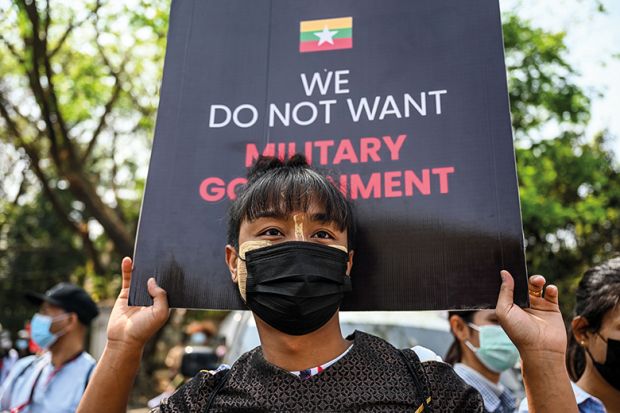Scores of campuses in Myanmar have been occupied by troops, leaving classrooms empty of lecturers and students. The military, which took over the country in a coup in February, continues to draw international condemnation as academics and students face arrest and violence.
Scholars at Risk (SAR), based at New York University, has appealed to the United Nations Human Rights Council to secure the release of detainees and protect fundamental rights such as academic freedom.
So far, more than 200 civilians have been killed, including Ma Kyal Sin, a student at Yadanabon University, and Khant Nyar Hein, a fresher at the University of Medicine 1 in Yangon.
More than 2,000 people have been detained, including Arkar Moe Thu, a lecturer at the University of Yangon, although the military did release some students on 24 March.
Sean Turnell, a Macquarie University economist who worked as a consultant to Aung San Suu Kyi, was still in detention.
As of 19 March, the military had occupied 60 school and university campuses, according to a report by aid agencies, which called on the military to “exercise maximum restraint and end all forms of occupation and interference with education facilities, personnel, students and other public institutions”.
Robert Quinn, SAR’s executive director, writes in the letter to the UN that “raids and occupations of universities indicate a clear effort to exercise control over Myanmar’s higher education community and violently quash dissent by students, scholars and other members of the campus community who have participated in protests”.
He says Myanmar’s universities had actually been in the process of opening up, but that the coup could “erase the important progress Myanmar has made in recent years, endangering the country’s higher education community”.
The Irrawaddy, a Thai-based news source with close ties to Burmese in exile, reported that occupied campuses and hospitals were being used as “base camps”. They included all universities in Mandalay, plus Dagon University in Yangon, the Myanmar Aerospace Engineering University, Monywa University of Economics in the Sagaing region and others.
Contacts in touch with academics in Myanmar said that the education ministry had ordered teachers back to their posts by 23 March or face dismissal. Some academics have given up involvement in the civil disobedience movement (CDM) to go back to campus, while others have not returned. The ministry has also allegedly collected CVs of academics, putting at risk those who may have been part of the protests.
Benedict Fleming, co-founder of the University Human Rights Education in Myanmar Project at Columbia University, told Times Higher Education that “there is extreme tension amongst those fully participating [in protests] versus those who feel unable to continue with the CDM”.
“Higher education employees are very much in the firing line. Many are on the run or in hiding. Many have been arrested,” said Mr Fleming, a former visiting lecturer at Mandalay University’s law school. “At one university, we know that more than 190 faculty and their family members are on the move, supported only by the communities protecting them.”
Those who have returned to their workplaces have found “empty campuses, bereft of students”, he said.
Kristina Eberbach, director of education at Columbia’s Institute for the Study of Human Rights, told THE that some classes are not taking place, and that student protesters are “not expected to return any time soon”.
Register to continue
Why register?
- Registration is free and only takes a moment
- Once registered, you can read 3 articles a month
- Sign up for our newsletter
Subscribe
Or subscribe for unlimited access to:
- Unlimited access to news, views, insights & reviews
- Digital editions
- Digital access to THE’s university and college rankings analysis
Already registered or a current subscriber? Login









